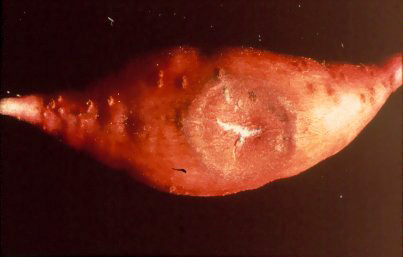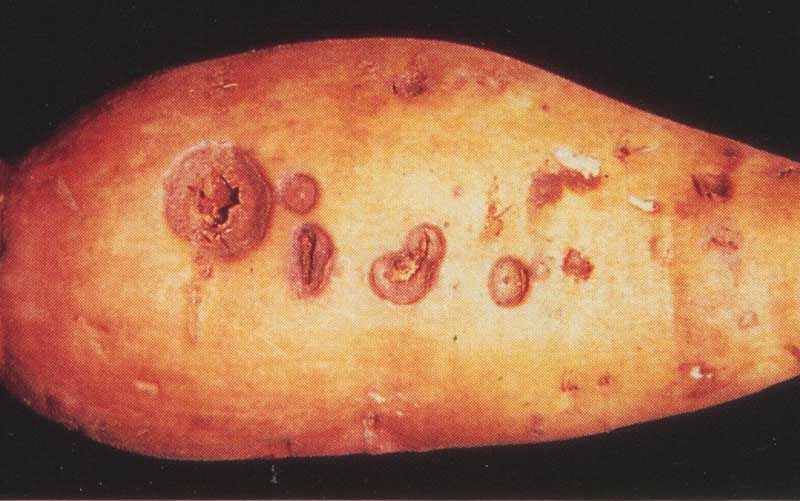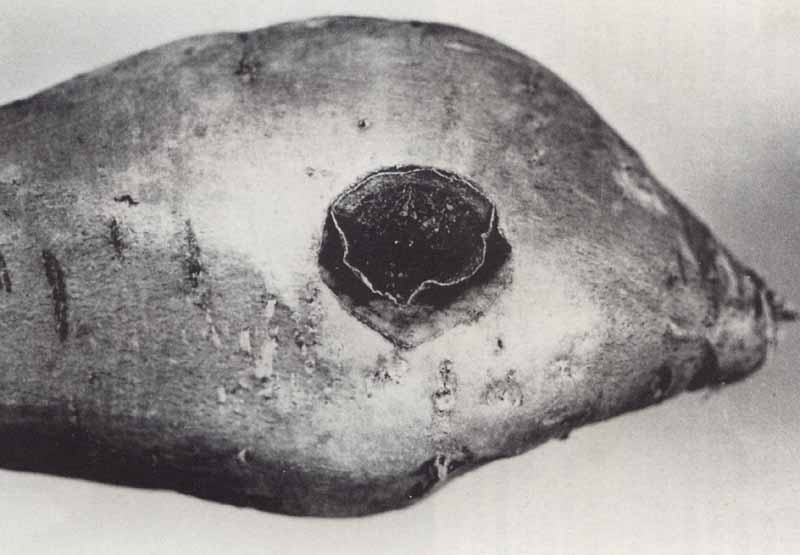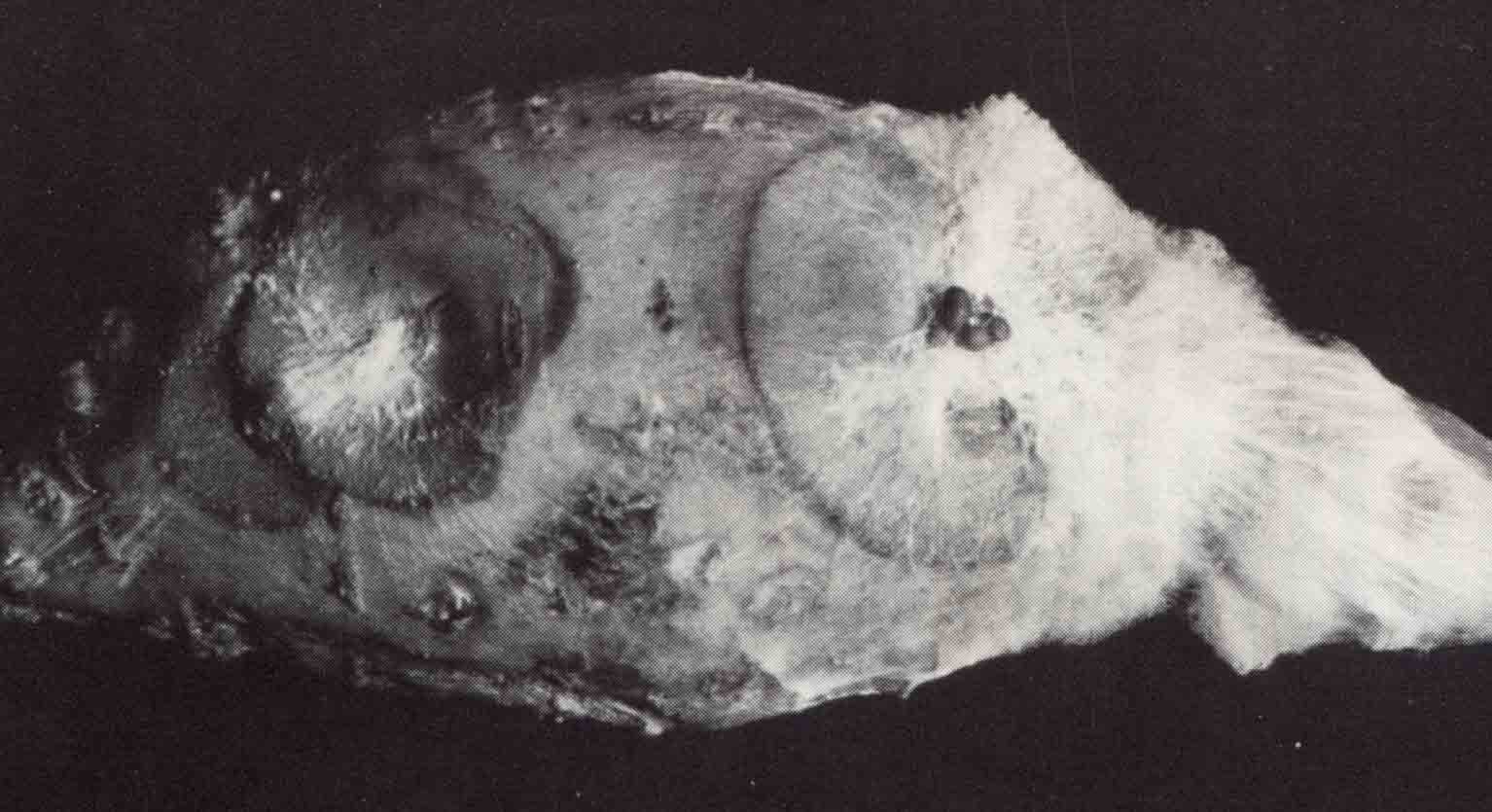|
| Kingdom |
Fungi |
| Phylum |
Basidiomycota |
| Class |
Basidiomycetes |
| Order |
Sterales |
| Family |
Corticiaceae |
An important and widespread problem, particularly on land that is frequently
cropped.
The fungus attacks many hosts and is present worldwide.
Circular lesions, typically 1-2 cm wide, with sharply
defined margins are observed at harvest. Lesions are usually shallow, about 1-5
mm deep, but on particularly susceptible cultivars, an extensive rot may
develop. Externally, the spot is brown, often with a slightly darker margin.
Tissue within the lesion is yellowish brown, soft and wet at harvest. It
becomes dark brown, sunken and leathery as it dries out in storage, often
cracking in the centre.
Affected roots have a distinctive bitter flavour.
The size of the lesion does not increase in storage as a rule. Normally
the lesion dries out within a few days, and may eventually be peeled off
exposing a healed wound surface. Only in very moist, warm storage
conditions can the fungus continue to spread, and white hyphae spread from the
centre of the lesion across the root surface.
Infection is usually at a late stage of development of the crop. Hence
lesions rarely cause any deformity in the shape of the storage roots.
The disease can also cause an unrestricted wet, soft
rot, common when infected storage roots are used as seeds in plant beds while
the lesions are still wet.
The mycelia are
white in early stages of development become tan as they mature and finally form
strands of brown pigmented hyphae. They measure 6-9 µm wide, have clamp
connections and numerous dikaryotic nuclei. The sclerotia
resemble mustard seeds, are round to irregular in shape, generally tan outside
and have a white medulla.
The basidial stage
has not been reported in sweetpotato.
S. rolfsii is a saprophyte that
kills the plant tissue in advance, producing pectolitic enzymes and cellulase,
which macerate the tissue. In the process, the cell walls and middle
lamellae are destroyed which facilitate infection. The fungus also produces high
amounts of oxalic acid.
The pathogen survives in the soil for several years in plant residues in the
upper 10 cm or slightly below the soil line. It prefers hot weather
conditions (28-30°C) and high humidity. It spreads by the mycelium growing
in the soil surface, or by mycelial fragments and sclerotia, by surface water,
or by mechanical means. Sclerotia can survive passage through the
digestive tract of cattle.
Circular spot is caused by the same pathogen that causes Sclerotial Blight,
but the two disorders are not necessarily concurrent in the field, possibly
because different strains are involved. The incidence of circular spot is
quite variable and unpredictable, and conditions favouring the disease are
poorly understood.
S. rolfsii has several antagonists that live in the soil which can be
important for integrated disease management. Some of the most important
species tested in the laboratory and field are: Trichoderma harzianum, T.
hematum, Aspergillus flavus, A. niger, Gliocladium virens, Serratia marsescens,
Pseudomonas fluorescens, Xanthomonas campestris and Bacillus subtilis.
The fungus is omnivorous and is
recorded to live on more than 500 plant species. Sweetpotato (Ipomoea batatas)
is considered a primary host together with soybean (Glycine max), maize (Zea
mays), sunflower (Helianthus annuus), rice (Oryza sativa),
bean (Phaseolus vulgaris), groundnut (Arachis hipogaea),
cotton (Gossypium hirsutum), pea (Pisum sativum), black
pepper (Piper nigrum), sugarcane (Sacharum officinarum), tomato (Lycopersicon
esculentum), bell pepper (Capsicum annuum), carrot (Daucus carota),
potato (Solanum tuberosum), sugarbeet (Beta vulgaris var.
saccharifera), wheat (Triticum aestivum), lentil (Lens culinaris subsp.culinaris),
chickpea (Cicer arietinum), broad bean (Vicia faba), taro (Colocasia
esculenta), flax (Linum usitatissimun), turmeric (Curcuma
longa), etc.
Secondary hosts are numerous, among them food crops and ornamentals, most of
them economically important. There are also a variety of weed hosts.
Symptomatic plants or plant parts are placed in a moist
chamber for 3 to 4 days; abundant fan-like mycelia grow from them and in few a
more days, sclerotia start forming.
Cultural control
Crop rotation with non-host crops could be an effective control for
sweetpotato.
Early harvest may reduce the extent of the disease.
Use of soil amendments. Amendments can be added to the soil to stimulate the
increase of antagonistic microorganisms.
Host-plant resistance
Very little is mentioned about resistance of sweetpotato plants to S.
rolfsii. However, differences have been found in the reaction of certain
cultivars to artificial inoculation.
Aycock, R. 1966. Stem rot and other diseases caused by Sclerotium rolfsii
or the status of Rolfs’ fungus after 70 years. N.C. Agric. Exp. Stn. Tech.
Bull. No. 174 202 p.
Clark, C.A., and Moyer, J.M. 1988. Compendium of sweetpotato diseases. The
American Phytopahological Society. APS Press, Minnesota, USA. 74 p.
Mordue, J.E.M.
1974. Corticium rolfsii. CMI Descriptions of Pathogenic Fungi and
Bacteria No. 410. 2 p.
Contributed
by: Teresa Ames
and
Jane O'Sullivan |
Taxonomy
Economic
importance
Geographical
distribution
Symptoms
Morphology
Biology
and ecology
Host
range
Inspection
and diagnosis
Management
References

Circular
lesion with defined margin on storage root ( W. Martin, APS).

Circular spot lesions after a period of storage, dried and sunken and
cracked from the centre out (C. Clark, APS).

Circular spot lesion after several weeks in storage. It has dried
out and begun to peel away (C. Clark, APS).

An infected root after incubation in high humidity, showing growth of the
fungal mycelium out of the lesions (C. Clark, APS).
|

